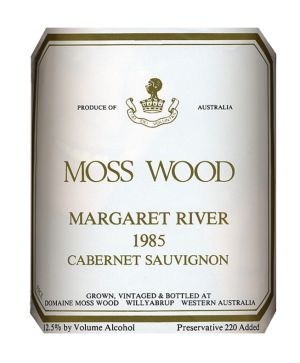Moss Wood 1985 Cabernet Sauvignon
Wine Facts
| Harvested: | 12/3/1985 |
| Bottled: | 25/11/1986 |
| Released: | 6/7/1987 |
| Yield: | 7.50 t/ha |
| Baume: | 12.50 |
| Vintage Rating: | 9/10 |
SOLD OUT
Tasting Notes
The 1985 Moss Wood Cabernet Sauvignon has a powerful bouquet with rich, berry fruit in harmony with the excellent French oak. The palate has power, elegance and style, with the lovely fruit characters being in balance with soft tannins. The wine has excellent structure, great depth of flavour and tremendous length.
We rank the 1985 Moss Wood Cabernet Sauvignon, with the 1980 and 1983 Moss Wood Cabernets, as one of our favourites. It has finer fruit characters, is more restrained and is in a more classical style than the 1983. The wine has rich fruit fragrances like the 1980, but is tighter. In terms of its weight and tannin it is similar to the 1981 but has better fruit and consequently better length of flavour. It is more typical of the Moss Wood style, having a richer structure, than the fine, elegant 1984, yet has the early drinkability of the previous vintage.
One group of experienced wine enthusiasts who tasted this wine blind thought it showed many of the qualities of the 1983 Bordeaux, and in particular the style of chateauxs like Pichon Lalande, Leoville las Cases and Ducru Beaucaillou. They were most impressed by what they considered to be an extremely well-made, refined wine showing lovely fruit qualities and excellent use of oak. As well as this, they were impressed by the depth and length of flavour.
Perhaps the greatest compliment so far paid to this wine comes from Bill Pannell. In the rating system used in Robin Bradley's Australian Wine Vintages, the highest rating he had given for a previous Moss Wood Cabernet was 5 (for the 1975, 1980 and the 1983 vintages). When asked by Robin Bradley how he rated the 1985, he replied, without any hesitation, that he would have to give it 7 (out of 7).
Vintage Notes
This wine was produced in a relatively mild growing season with good vine balance and soil moisture. The vines showed their ability to cope with difficult circumstances during a hot spell in February and have produced a wine that is both stylish and rich in fruit character.
Production Notes
The fermentation takes place in open, stainless steel tanks which keep the temperatures at about 25ºC. The grapes are hand plunged between three to six times a day to encourage fermentation with the wine being left on the skins until there is an adequate extraction of colour and flavour. In most cases this lasts until fermentation is completed.
The wine is then pressed using a basket press which causes minimum damage to the skins and the seeds. This reduces the possibility of producing tannins which are extremely dominant or bitter. All pressings are then included in the blend to ensure the wine has sufficient tannin so that the wine has strength and the fruit backbone. At first, we were very careful about the volume of pressings used but it became increasingly clear that the use of the basket press and the excellent fruit produced in the vineyard would enable him to use virtually all the pressings in making this wine.
After pressing, the wine is racked (transferred) into stainless steel tanks without any fining or filtration and allowed to clarify naturally. It remains in tanks for four to five months during which time it usually undergoes its malolactic fermentation. This secondary (or malolactic) fermentation has been a feature of the Moss Wood Cabernets since 1982 and has led to more complex, classical wines being produced.
Following the clarification stage, the wine is racked into small barrels, 30% of which are new each year. It then spends about twelve months in French oak. Because each barrel gives a different flavour to the wine contained in it, it is necessary to blend the wines after their period in oak. After blending, the wine is filtered. At Moss Wood, Keith Mugford is careful not to fine too heavily or filter to such an extent that the fruit character of the wine is impaired.
Finally, the Cabernet Sauvignon is bottled and kept for six months so that the wine can recover from the relatively harsh bottling process before it is released.


